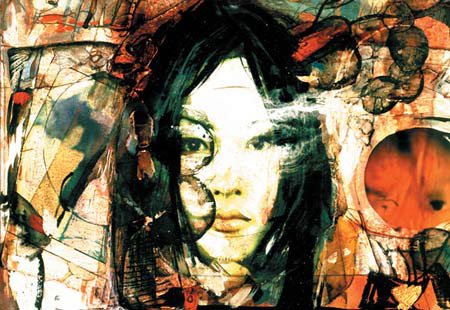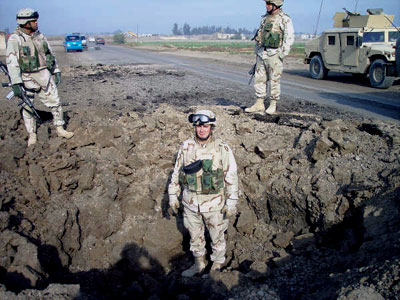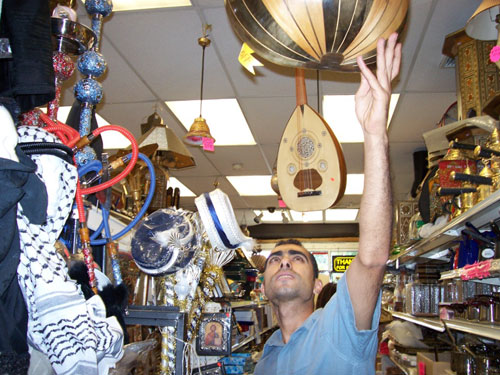
Zaher parks his 2001 Chevy stick-shift on Main Street in Paterson, New Jersey.
“When I go to Paterson, I feel like I’m in Gaza,” he says happily.
On Main St., where at least half the shops and restaurants are Arab-owned, he makes his way into Nouri’s Brothers, an enormous Middle Eastern general store selling everything from fresh olives to halal marshmallows, gold jewelry to backgammon sets, Arabic and Turkish pop music to electronics.
But what Zaher, a slim, unassuming Palestinian from the Gaza Strip, has come to look at are a couple of ouds — Middle Eastern lutes — hanging from the ceiling. He runs his fingers along the deep bowl of one and then lightly touches its strings.
“This is good for a beginner,” he says, explaining that the strings are a little too close to the fingerboard for his taste. He might have to go into New York City to find what he’s looking for, he adds.
Buying another oud — he owns two already — is no small undertaking for Zaher. If it weren’t for his ability to play the oud, he probably never would have come to the United States or obtained political asylum here. (To protect family members still in Gaza, Zaher asked that his last name not be used in this article.)
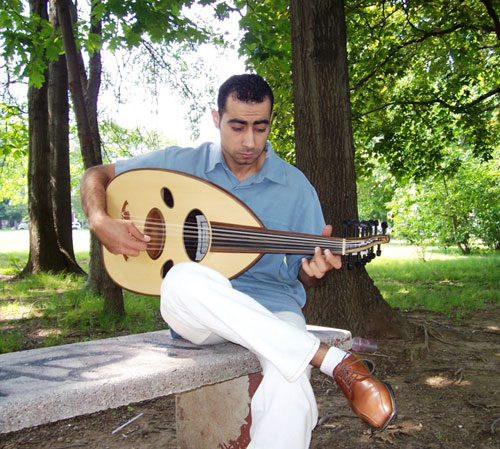
Ancient music made new
Once upon a time, back when he lived in Gaza, before the second intifada started in 2000, Zaher played the oud in a joint Palestinian-Israeli band based in Tel Aviv. The band was called “White Flag,” a name that represented its members’ hope for a cessation of violence on both sides and a peaceful solution to the Israeli-Palestinian conflict.
Now, more than half a decade later, Zaher lives in Clifton, New Jersey (one town over from Paterson), works at a Domino’s Pizza, and waits for the day this fall when he is eligible to apply for a green card. He borrows books on Renaissance painting and CDs ranging from classical music to Celine Dion from the public library and dreams of getting a master’s degree in the U.S.
“I was lucky,” he says about coming to the U.S. and getting asylum.
Indeed, Zaher’s experience is very uncommon: it is hard for Palestinians, especially those from Gaza, to travel abroad, and few Palestinians are granted asylum in the U.S. But it’s also a testament to Zaher’s innately upbeat personality that he feels lucky in spite of the difficulties he’s faced, like threats from Hamas and a three-month stint in an immigrant detention center in New Jersey.
Zaher’s dark hair and eyes frame a face that seems older than his 29 years. He dresses nicely, never sloppily: tan pants, tan leather dress shoes, button-down shirt, black leather jacket. But when he goes into work at Domino’s, he becomes just another guy in a red Domino’s shirt and a white cap. At first meeting he is serious, but he soon reveals himself to be someone who likes to laugh.
“He is quiet, and he doesn’t make a problem, and when you ask him to do something he does it. And he’s smart,” said his sister, Abeer Haj Ahmmed, who immigrated to the U.S. seven years ago and also lives in Clifton.
None of these qualities seem surprising in someone who taught himself to play the oud while growing up in a refugee camp, Deir al Balah, in the Gaza Strip. The oud, a popular Middle Eastern instrument that is the origin of the Western-style lute, is difficult to learn. “In all the Arab world, there are maybe a maximum of 10 people really playing the oud,” Zaher says. Arguably the most well-known oud player in the West is Simon Shaheen, an Israeli-born Palestinian who lives in New York and incorporates non-traditional musical styles such as jazz into his work.
“We didn’t study music in the schools. We didn’t know anything about music,” Zaher recalls. Nevertheless, while in high school and later while studying special education at the College of Rehabilitation Studies run by the Palestine Red Crescent Society in Gaza, he taught himself the oud from books and by watching other musicians; later, he also learned to play the violin.
Eventually, Zaher joined a traditional Arabic music ensemble in Gaza called “Orient Strings,” composed of about 15 musicians playing Middle Eastern instruments like the oud, qanun (zither), ney (flute), and darbuka (drum), as well as violins and a cello. The group performed classical Arabic music — some of it as old as the muwashahat, a body of songs that originated during the period of Muslim rule in Spain — as well as more contemporary music by Arab divas like Umm Kulthum and Fairuz.
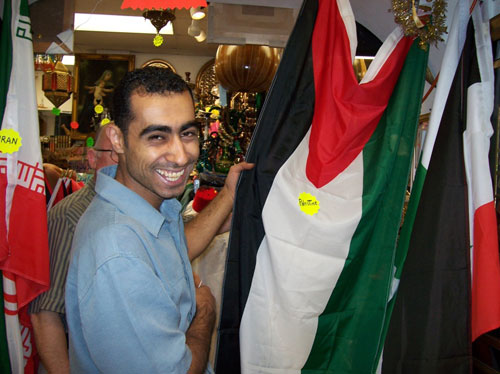
Making music across borders
In 1998, Zaher went to Tel Aviv for the first time with his friend Shadi and another musician, a trip that would change his life. There, they performed in a fundraiser for Windows, an organization that promotes relations between Palestinians and Israelis and with which Shadi was already connected.
That era, after the 1993 Oslo Accords but before the second intifada began in 2000, was a time of greater optimism than today. “The relation between the Palestinians and the Israelis was great: a lot of people coming and going; there is no war, no intifada, no nothing,” Zaher recalls. “We made this concert and it was very nice; there were also some Israeli musicians. There was one [Israeli] guy, Mark. He told us, ‘How about if we make a band?’ [We said,] ‘A great idea, but how? We cannot come here; it’s difficult.’”
Since 1991, the Israeli policy of “closure” has restricted to varying degrees the entry of Palestinian residents of Gaza and the West Bank into Israel.
According to Ilana Feldman, a professor in Near Eastern Studies at New York University who has done anthropological fieldwork in Gaza, “The first closure policy happened during the Gulf War but it wasn’t made permanent … till Oslo. No Palestinian can cross the Green Line without a permit … Most of the permits were given to people who worked in Israel.”
Zaher’s father worked as an electrician in Israel until 1991, when it became too difficult for him to get to work; he then opened a grocery store below the family’s house in Gaza.
For males under 35, who are seen as a potential security threat, it is particularly difficult to obtain permits to enter Israel, which meant that Zaher and his musician friends were at a disadvantage. However, with help from Windows, they were able to obtain permits that allowed them to travel back and forth for rehearsals and performances.
“You cannot play again with this band”
Zaher and the other Palestinian and Israeli musicians formed a band, and Zaher himself came up with the name White Flag. He chose it, he said, because it symbolized a truce. “The white flag means between two sides, two parts of a problem, between Palestinians and Israelis, [if] they want to stop this war, they have to take a white flag. Both sides.”
The band performed songs in Hebrew, Arabic, and English, and drew from a range of musical styles and traditions. “We call it street fusion, because we cannot find a name for this music,” Zaher says. “We want to make music from the heart.”
But the dream came to an abrupt end when the second intifada began in September 2000 — literally during the Bereshit festival, in which the band was to play.
“That day was the last day in Tel Aviv,” Zaher recalls. “The intifada started when we were in the festival. We heard by the news, there are problems in Gaza and there are like twenty people killed. Now, we didn’t play yet, but we heard about this news. How’re we going to play? And we sat together, all the band — the Palestinians and the Israelis — and we said, what are we going to do? We said, we want to play. Because we make music, and we play for this problem. Maybe we’ll fix something.”
Zaher says the audience, most of whom had not previously heard of White Flag, reacted positively to their music and their message. “The people were dancing,” he remembers.
But after the concert, Zaher returned to Gaza and the political realities of the intifada changed everything. Because the Bereshit festival had been shown on TV, Zaher’s peace advocacy through White Flag had become known in his community and he was seen as a “collaborator” with the Israelis.
A member of Hamas, the militant Islamist Palestinian movement, came into his family’s store one day while he was working. “They give me a letter,” Zaher says. “They told me you cannot play again with this band”— or else his life would be in danger.
Members of Fatah, the more moderate political party that was then running the Palestinian Authority, also paid him visits. They came “as friends,” he says, but their message was similar. “They told me, it is better for you if you leave [White Flag]. It’s dangerous for you.” Zaher says he felt his life to be in danger after the threats and stopped being openly involved with White Flag — which, due to the intifada, which made travel impossible, had effectively been put on hold anyway. But he and the other members of the band kept in touch by phone.
Zaher had reason to fear what might happen to him. Shadi, his friend who became White Flag’s keyboard player, had also been threatened and then, after the Bereshit festival, imprisoned by the Palestinian Authority. “They think he is a collaborator, but they have to make some proofs. They kept him in jail for like a month,” recalls Zaher. Shadi was eventually released when the P.A. couldn’t prove his culpability, and he escaped to Switzerland, where he lives today.
Nearly five years later, when Zaher applied for asylum in the U.S., his case rested largely on the threats he had received from Hamas and Fatah and on a “credible fear” of further persecution if he returned to Gaza.
As his lawyer, Thomas Mungoven, explains, “It was a textbook collaborator case…[T]here’s a pattern and practice of persecution of collaborators in Gaza. Collaborators are regularly killed … by Hamas.”
The future is here
Zaher is glad to be in the U.S. now, and not just because he has escaped further political persecution in Gaza. “There is no future there,” he says.
His sister Abeer is also delighted to have him here. “I have seven brothers. But I love Zaher so much,” she says. “I’m so happy, I’m so glad. Because no one from my family [was] here.”
In fact, Abeer is the reason that Zaher came to the U.S. in the first place. In 1998, Abeer got married and joined her husband — a Palestinian who had originally come to the U.S. to study — in New Jersey. In 2004, she sent an official invitation for Zaher and their mother to visit her and her family. But getting into Israel to go to the American Embassy in Tel Aviv was still difficult. With help from the director of Windows, Rutie Atsmon, Zaher was able to obtain an entry permit.
When they got to the Embassy, Zaher recalls, “I don’t imagine [that] they’re going to give me a visa. It’s not easy.” But in the interview with the U.S. Consul, he talked about his involvement with White Flag, and the Consul was impressed.
“And she gives us a visa!” he says, laughing wholeheartedly, as if still surprised about it. “You know, I’m sure, if you check the last ten years, there is nobody [who got] a visa from Gaza — just me I think.”
Zaher is not the only Gazan to have gotten a U.S. visa in the last decade, but anecdotal evidence suggests that there have not been many. Feldman says this is in large part because “it was much harder, after Oslo, for Palestinians to get out of Gaza,” which is completely fenced in, than the West Bank, which, until the last few years, had a more porous boundary with Israel.
According to Karen Pennington, a lawyer based in Dallas who has represented a number of Palestinian asylum-seekers, “Tracking any numbers on Palestinians is very difficult in the U.S. immigration service. Because if they were born in the Occupied Territories after 1967, they’re listed as Israelis. If they have any other citizenship, they’re listed that way, not as Palestinians.” But Pennington agrees that few Gazans make it to the U.S. “I only represent a handful of people from Gaza. Almost everyone I represent is from the West Bank or diaspora Palestinians.”
Nonetheless, for Zaher, getting the visa proved to be the easy part, compared to leaving Gaza. Flying out of Gaza is impossible, both because Israel does not allow it and because it destroyed the Gaza airport’s runway in 2001; therefore, Gazans traveling internationally must fly out of neighboring Egypt. But at the time, the Gaza-Egypt border crossing at Rafah was closed for three weeks. Zaher’s mother had by then decided not to go to the U.S. because her daughter-in-law in Gaza had just had a baby. But Zaher was determined to go.
Laughing at the absurdity of it, he describes the situation: “Every week I go two, three times, and take my luggage, and I say [bye] to my family and I go [to the border] and I come back.”
It ended up taking him a couple months, and at least half a dozen attempts, before he could leave. The border was finally opened but, at first, only for women; then, men older than 35 were allowed to cross. Finally, younger men were allowed to leave, but only if they applied in advance for approval and waited for the Palestinian Authority to announce their names over the radio.
“They told us, who[ever] hears his name on the radio, he can come next day to the border. And all the day, you’re hearing news. And when I hear my name — check!” he says, laughing.
Once past the border and into Egypt, the waiting continued. “When I entered [Egypt] it was Friday, but my ticket was [for] Monday. I had to stay three days in Egypt.”
Zaher had been to Egypt once before, in the mid-1990s, also for three days. In those years, it had been easier for Palestinians to obtain visas for Egypt, and Zaher and a friend from his college took a pleasure trip. From the border with Gaza they took a half-day bus ride to Cairo, where, among other things, they each bought an oud, of higher quality than any they could get in Gaza.
But this time, “Because I don’t have an Egyptian visa, I could not travel in Egypt,” he explains. “I had to be in the airport for three days. In one big room, there were like 50 people waiting;” they slept on mattresses. “Also it was Ramadan, and we were fasting.”
In late 2004, Zaher finally made it to the U.S., where he stayed with his sister and her family. He wanted to study in the U.S. but learned he could not do so because he had a visitor’s visa. “I was really trying to enter school but it was very difficult, because I don’t have a student visa. They told me you have to go to your country to get a student visa, and you come back … Impossible! How am I supposed to get this visa?”
So Zaher began to familiarize himself with life in the U.S. while trying to figure out what to do next.
“Exile” and return
In 2005, with help from a Swiss television company that had begun a documentary about White Flag before the intifada, the band was invited by the city of Lucerne to do a summer-long residency. The Swiss Consulate initially told Zaher he would have to go back to his home country to get a visa but, thanks to a letter on his behalf from the mayor of Lucerne, Zaher obtained a three-month visa to travel to Switzerland. There, the band members were reunited for the first time in almost five years. They performed in two festivals and recorded their first album, “Exile.”
After the summer in Switzerland, Zaher decided to return to the U.S. “I thought to myself, okay, I have a visa to go to United States; it is multiple entrance. By the law I don’t make any mistake,” he says.
But U.S. Immigration detained him at JFK airport, threatening to send him back to Gaza. As later became clear, Zaher had, unaware, been registered under the Department of Homeland Security’s “Special Registration” program when he had first arrived in the U.S. Registered individuals are required to inform DHS when they leave the country but, not knowing that he had been registered, he had not done that.
According to Mungoven, Zaher should never have been registered, because Palestinians are not on the list of nationalities subject to registration. “It was total racial profiling,” says Mungoven. Furthermore, “they lied about it when I called up … They said he was from Jordan.”
Zaher, who knew nothing about the special registration program or its requirements, was confused, though not exactly surprised, by what happened. “I was feeling … something’s going to happen … I think, from 9/11, [for] all the Arab people, if they read your name — Zaher, Muhammad, Abdallah, Musharraf, these names — I think they put like a red sign. I don’t know.”
Fearing further threats from Hamas and Fatah if he returned to Gaza — especially given that White Flag’s performances in Switzerland had been publicized back in Israel and Palestine — he decided to apply for asylum in the U.S. “Because I don’t want to go back to my country,” he says. “A lot of problems. I don’t want to live there. This is no life.”
Zaher spent the next three months in the Elizabeth Detention Facility, in Elizabeth, N.J., with other immigrants and asylum seekers, waiting for his asylum case to be heard. The detention conditions were tolerable, he says. “If you make problems, maybe it’s going to be bad. And there’s rules you have to follow … but I don’t remember anything bad. They have good food,” he says. On Ramadan, he and other Muslim detainees were even able to fast and have their meals brought when they wanted them.
But even though detention wasn’t miserable, it was still a difficult experience for Zaher. “I was in shock. Because there is no life there. You just sleep, wake up, sleep, wake up. I was dreaming to get my oud there,” he says. (He had one oud with the luggage he had brought to Switzerland; the other — the one he bought in Cairo — is back in Gaza.) “I requested, but they said no.”
Abeer went with her children to visit Zaher in Elizabeth, but it was a hard experience for all of them. “I’m sad when I see him like this. It’s not easy when you see your brother in jail,” she says. “I went just two times.” After that, “he said, ‘Don’t come.’ Maybe because I cry when I see him.”
Through case workers and fellow detainees, Zaher got in touch with Mungoven, who works at Catholic Charities of the Archdiocese of Newark on pro bono immigrant detention cases. The asylum process was as complicated as every other stage of coming to the U.S. had been.
Asylum
“When I applied for asylum, they said, ‘no asylum,’” Zaher says, speaking of the U.S. authorities.
Pennington, the Dallas lawyer, says it has become “extremely” difficult for Palestinians to get asylum in the U.S. Of “20 to 25 or perhaps more” Palestinian asylum cases she’s taken on since September 11, 2001, “about seven were granted,” she says. And while there are significant numbers of Palestinians applying for asylum because of persecution by Israelis, U.S. judges have been showing less willingness to grant those cases than collaborator cases.
For example, Pennington describes the recent case of a banker from Ramallah who was detained and fired on by the Israel Defense Forces (IDF) on several occasions. “I demonstrated in that case that the behavior of the IDF violated the written regulations for live-fire. And [the court] still found that it was state policy,” she says. “The judge said it didn’t have anything to do with American foreign policy, but …” Pennington, for one, believes otherwise.
Even though Zaher’s case was a “collaborator” case and theoretically easier to win, the judge did not grant Zaher asylum at his court hearing in late October 2005. Instead she gave Zaher “withholding of removal.” He would not be sent back to Gaza, but neither would he have asylum, and he would have none of the privileges of a green card. But it was better than nothing.
Zaher returned to the detention facility and prepared to be picked up by Abeer that night. But DHS and ICE (Immigration and Customs Enforcement) had changed their minds, apparently: They now told him that they were going to send him back to Switzerland. (His “withholding of removal” status only prevented him from being sent back to Gaza.)
Zaher called Mungoven, who spoke to the judge, and two days later the case was reopened. Mungoven was furious at what had happened, but so was the judge — who didn’t like DHS trying to undercut her. “It was like fighting between the judge and Immigration,” says Zaher. The judge ended up giving Zaher full political asylum, to his great relief, and he was released from detention.
Since then, Zaher has been working at Domino’s taking phone orders and making pizzas, while continuing to settle in to life in the U.S. and considering his next step.
Abeer seems to know exactly what she wants for her brother: “I hope he goes to college and gets a master’s here. I hope he marries too. He needs a family here,” she said.
As for Zaher? He wants those things too. But first, he’s still looking for another oud.
In The Fray Contributor
Dear Reader,
In The Fray is a nonprofit staffed by volunteers. If you liked this piece, could you
please donate $10? If you want to help, you can also:












